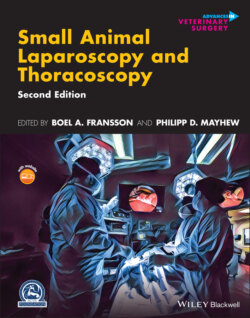Читать книгу Small Animal Laparoscopy and Thoracoscopy - Группа авторов - Страница 69
References
Оглавление1 1 Wolfe, B.M., Szabo, Z., Moran, M.E. et al. (1993). Training for minimally invasive surgery. Need for surgical skills. Surg. Endosc. 7: 93–95.
2 2 Soper, N.J. and Hunter, J.G. (1992). Suturing and knot tying in laparoscopy. Surg. Clin. North Am. 72: 1139–1152.
3 3 Kenngott, H.G., Muller‐Stich, B.P., Reiter, M.A. et al. (2008). Robotic suturing: technique and benefit in advanced laparoscopic surgery. Minim. Invasive Ther. Allied Technol. 17: 160–167.
4 4 Kaan, H.L. and Ho, K.Y. (2019). Endoscopic robotic suturing: the way forward. Saudi J. Gastroenterol. 25: 272–276.
5 5 Tuncel, A., Lucas, S., Bensalah, K. et al. (2008). A randomized comparison of conventional vs articulating laparoscopic needle‐drivers for performing standardized suturing tasks by laparoscopy‐naive subjects. BJU Int. 101: 727–730.
6 6 Ramani, A.P., Braasch, M., Botnaru, A. et al. (2008). Evaluation of efficacy of four laparoscopic needle drivers. JSLS 12: 77–80.
7 7 Tidwell, J.E., Kish, V.L., Samora, J.B. et al. (2012). Knot security: how many throws does it really take? Orthopedics 35: e532–e537.
8 8 Kadirkamanathan, S.S., Shelton, J.C., Hepworth, C.C. et al. (1996). A comparison of the strength of knots tied by hand and at laparoscopy. J. Am. Coll. Surg. 182: 46–54.
9 9 Muffly, T., McCormick, T.C., Dean, J. et al. (2009). An evaluation of knot integrity when tied robotically and conventionally. Am. J. Obstet. Gynecol. 200: e18–e20.
10 10 Shatkin‐Margolis, A., Kow, N., Patonai, N. et al. (2015). The effect of an air knot on surgical knot integrity. Female Pelvic Med. Reconstr. Surg. 21: 160–163.
11 11 Arbaugh, M., Case, J.B., and Monnet, E. (2013). Biomechanical comparison of glycomer 631 and glycomer 631 knotless for use in canine incisional gastropexy. Vet. Surg. 42: 205–209.
12 12 Vakil, J.J., O'Reilly, M.P., Sutter, E.G. et al. (2011). Knee arthrotomy repair with a continuous barbed suture: a biomechanical study. J. Arthroplast. 26: 710–713.
13 13 Zaruby, J., Gingras, K., Taylor, J. et al. (2011). An in vivo comparison of barbed suture devices and conventional monofilament sutures for cosmetic skin closure: biomechanical wound strength and histology. Aesthet. Surg. J. 31: 232–240.
14 14 Brody, F., Rehm, J., Ponsky, J. et al. (1999). A reliable and efficient technique for laparoscopic needle positioning. Surg. Endosc. 13: 1053–1054.
15 15 Szabo, Z., Hunter, J., Berci, G. et al. (1994). Analysis of surgical movements during suturing in laparoscopy. Endosc. Surg. Allied Technol. 2: 55–61.
16 16 Szabo, Z. (2008). Laparoscopic Suturing System with Szabo‐Berci Needle Driver Set. Tuttlingen, Germany: Karl Storz GmbH & Co.
17 17 Shettko, D.L., Frisbie, D.D., and Hendrickson, D.A. (2004). A comparison of knot security of commonly used hand‐tied laparoscopic slipknots. Vet. Surg. 33: 521–524.
18 18 Fugazzi, R.W., Fransson, B.A., Curran, K.M. et al. (2013). A biomechanical study of laparoscopic 4S‐modified Roeder and Weston knot strength in 3‐0 polyglactin 910 and 3‐0 polydioxanone. Vet. Surg. 42: 198–204.
19 19 Ragle, C.A. and Schneider, R.K. (1995). Ventral abdominal approach for laparoscopic ovariectomy in horses. Vet. Surg. 24: 492–497.
20 20 Gantert, W.A., Bhoyrul, S., and Way, L.W. (2008). Suturing and knot tying. In: Advanced Videoscopic Surgery for the General Surgeon (ed. L.W. Way). San Francisco, CA: University of California San Francisco.
21 21 Adams, J.B., Schulam, P.G., Moore, R.G. et al. (1995). New laparoscopic suturing device: initial clinical experience. Urology 46: 242–245.
22 22 Stringer, N.H. (1996). Laparoscopic myomectomy with the endo stitch 10‐mm laparoscopic suturing device. J. Am. Assoc. Gynecol. Laparosc. 3: 299–303.
23 23 Nguyen, N.T., Mayer, K.L., Bold, R.J. et al. (2000). Laparoscopic suturing evaluation among surgical residents. J. Surg. Res. 93: 133–136.
24 24 Pattaras, J.G., Smith, G.S., Landman, J. et al. (2001). Comparison and analysis of laparoscopic intracorporeal suturing devices: preliminary results. J. Endourol. 15: 187–192.
25 25 Omotosho, P., Yurcisin, B., Ceppa, E. et al. (2011). in vivo assessment of an absorbable and nonabsorbable knotless barbed suture for laparoscopic single‐layer enterotomy closure: a clinical and biomechanical comparison against nonbarbed suture. J. Laparoendosc. Adv. Surg. Tech. A 21: 893–897.
26 26 Akers, R.N. and Naumann, R.W. (2010). Laparoscopic vaginal cuff closure comparing endostitch to the RD‐180. J. Minim. Invasive Gynecol. 17: S76–S77.
27 27 Coleman, K.A., Adams, S., Smeak, D.D. et al. (2016). Laparoscopic gastropexy using knotless unidirectional suture and an articulated endoscopic suturing device: seven cases. Vet. Surg. 45: O95–O101.
28 28 Coleman, K.A. and Monnet, E. (2017). Comparison of laparoscopic gastropexy performed via intracorporeal suturing with knotless unidirectional barbed suture using a needle driver versus a roticulated endoscopic suturing device: 30 cases. Vet. Surg. 46: 1002–1007.
29 29 Brehmer, B., Moll, C., Makris, A. et al. (2008). Endosew: new device for laparoscopic running sutures. J. Endourol. 22: 307–311.
30 30 Martinschek, A., Ritter, M., Heinrich, E., and Trojan, L. (2017). Robot‐assisted laparoscopic suturing of a U‐shaped ileal neobladder with ENDOSEW. Videourology 31 http://doi.org/10.1089/vid.2017.0015.
